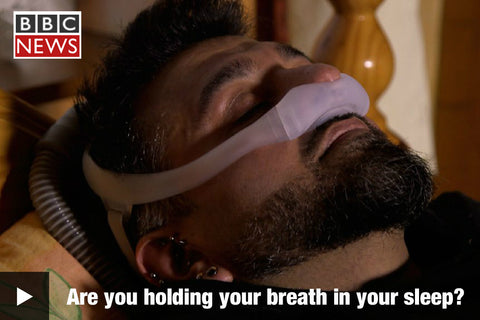Obstructive sleep apnea, often referred to as OSA, is characterised by loud snoring that occurs before a person stops breathing and is a condition that causes the throats of sufferers to close up while they sleep, meaning their brain has to continually wake them up from a deep sleep in order to reopen the throat muscles.

Watch this BBC NEWS film that describes Obstructive Sleep Apnea
The breathing pause can last a few seconds or several minutes and may happen many times during the night. It has been linked to daytime sleepiness and a host of other diseases.
Risk factors for sleep apnea include obesity, being over the age of 55, and smoking. Tests have proven that sleep apnea can be hereditary, and men outnumber women among those who are afflicted with the disease. Consequently, stopping smoking or taking dietary precautions prompting weight loss can reduce or even eliminate the effects of many sleep disorders. However, no age group is immune to a sleep disorder.
The overall number of people with OSA is known to be increasing due to major lifestyle problems such as more people now being overweight. Actual numbers are difficult to record as most cases go undiagnosed, but the increased number of nationwide Sleep Disorder Centres in the USA gives us a good idea of the growth of OSA. They have risen in total from 2.280 in 2010 to just over 2,850 in 2016. Their estimated revenue shows OSA is costing $7 billion per year, estimated to rise to $10 billion by 2020.
Similar figures exist for other countries but the economic impact of sleep apnea extends beyond the economic revenue for those who are treated the disease. The annual economic burden of undiagnosed sleep apnea in the USA is about $149.6 billion, according to the American Academy of Sleep Medicine. This includes nearly $87 billion in lost productivity, $26 billion in car crashes and $6.5 billion in workplace accidents.
Untreated sleep apnea leads to a host of other serious health problems including hypertension, heart disease, diabetes and depression. As a result, undiagnosed sleep leads to $30 billion a year in increased health care costs. The AASM estimates if everyone who suffers from sleep apnea received treatment, it would create a savings of just over $100 billion.
Chronic sufferers are advised to use CPAP machines every night when they sleep and this involves wearing a mask that fits over their nose, or their nose and also their mouth. The device increases air pressure in a patient’s throat, prevents the airway from collapsing, and eliminates obstructed breathing.
However a high number of patients struggle to adjust to CPAP machines and use other approved medical solutions and treatments such as an oral appliance that shifts the lower jaw forward opening airways during sleep. This Mandibular Adjustment Device (MAD) will successfully address the problem of obstruction of the airway and restore normal sleep.
As said earlier, men have a higher risk of sleep apnea, but recent studies are finding that women who have experienced menopause have the same risk as men. Weight and genetics also have an impact.
Some patients seek treatment after a partner complains about their loud snoring, or gaps in their breathing, but for those who live alone it might be tougher to diagnose.
Snoring is a common phenomenon, but some snorers may require medical treatment so they should look for the following key indicators that may indicate that they have sleep apnea. These include daytime fatigue, lapses into sleep during the day, and impairment of normal activity.
If snoring results in them having headaches in the morning, suffer from bouts of irritability, or have any of the other symptoms, or if it disturbs their partner, then they should seek to prevent this by using an oral appliance (MAD) which does not need a Doctor’s prescription, and do so immediately, and in severe cases they should seek out immediate medical advice.
John Redfern
